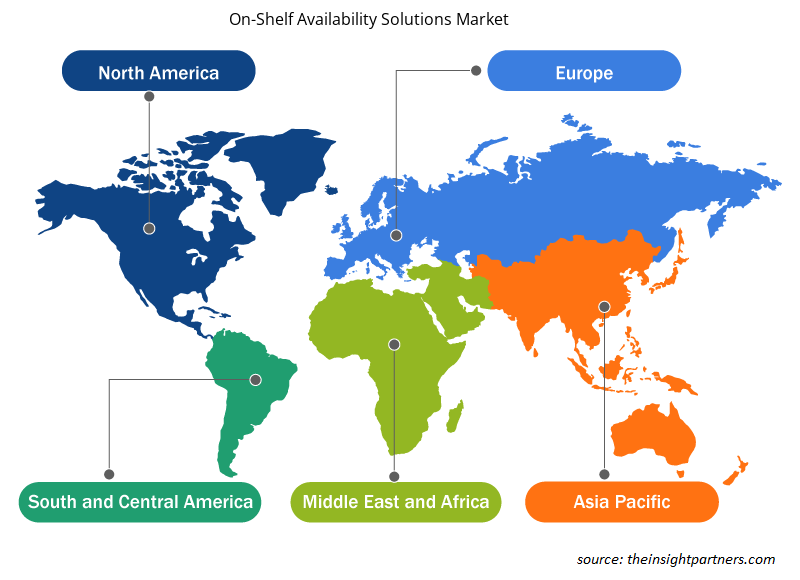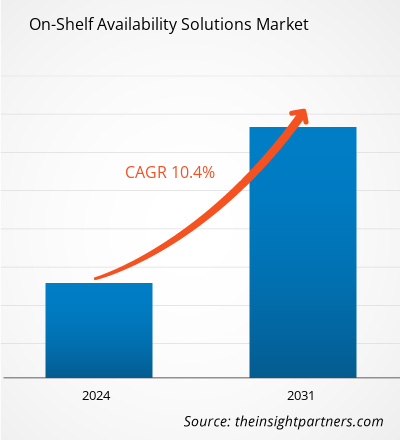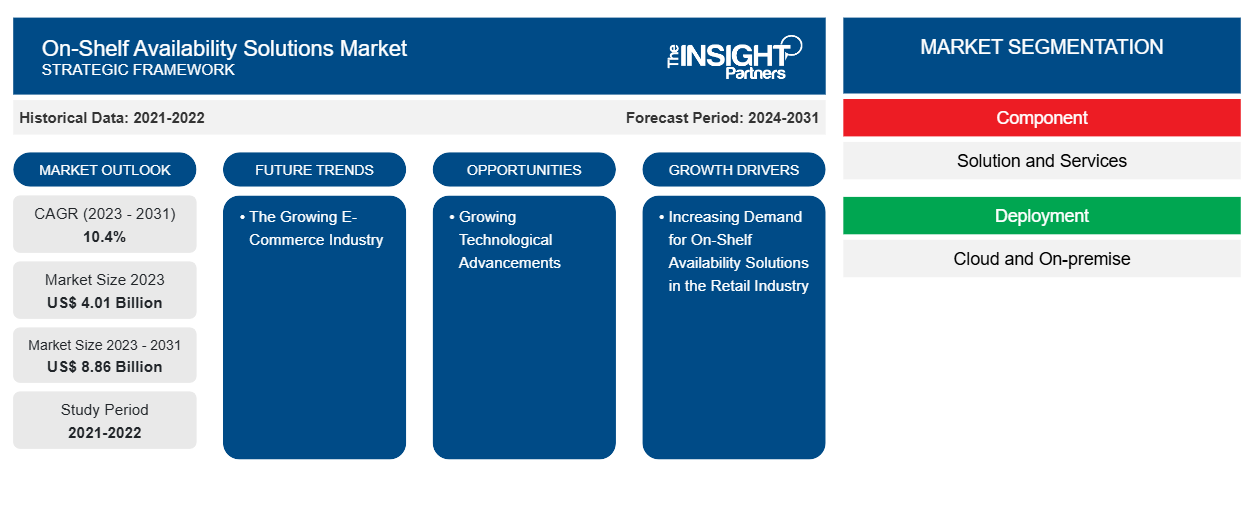La taille du marché des solutions de disponibilité en rayon devrait atteindre 8,86 milliards USD d'ici 2031, contre 4,01 milliards USD en 2023. Le marché devrait enregistrer un TCAC de 10,4 % en 2023-2031. Le secteur croissant du commerce électronique devrait rester une tendance clé du marché des solutions de disponibilité en rayon.
Analyse du marché des solutions de disponibilité sur étagère
Le nombre croissant de magasins de détail dans le monde augmente la demande de solutions de disponibilité en rayon dans le secteur de la vente au détail, ce qui est l'un des principaux facteurs alimentant la croissance du marché. En outre, la demande croissante de solutions omnicanales et l'accent croissant mis sur l'expérience client stimulent la croissance du marché. En outre, l'intégration croissante de technologies avancées telles que l'IA, le ML, la vision par ordinateur et d'autres créent une opportunité de croissance du marché des solutions de disponibilité en rayon dans les années à venir.
Aperçu du marché des solutions de disponibilité sur étagère
La disponibilité en rayon fait référence à la présence d'un produit dans les rayons d'un magasin lorsqu'un client arrive pour l'acheter. La disponibilité en rayon garantit que les clients peuvent acheter facilement et sans problème le produit qu'ils désirent. Pour le détaillant, elle assure la satisfaction du consommateur ainsi qu'une augmentation des revenus provenant des ventes de produits. La disponibilité en rayon aide également les fabricants, car elle garantit la vente de leurs produits et offre des informations utiles pour le contrôle des stocks. Par conséquent, dans le secteur de la vente au détail, la disponibilité en rayon est un facteur crucial qui doit être surveillé et maintenu efficacement.
Personnalisez ce rapport en fonction de vos besoins
Vous bénéficierez d'une personnalisation gratuite de n'importe quel rapport, y compris de certaines parties de ce rapport, d'une analyse au niveau des pays, d'un pack de données Excel, ainsi que de superbes offres et réductions pour les start-ups et les universités.
-
Obtenez les principales tendances clés du marché de ce rapport.Cet échantillon GRATUIT comprendra une analyse de données, allant des tendances du marché aux estimations et prévisions.
Moteurs et opportunités du marché des solutions de disponibilité sur étagère
Demande croissante de solutions de disponibilité en rayon dans le secteur de la vente au détail
Les fondamentaux des opérations en magasin continuent de poser problème à de nombreux détaillants, souvent parce qu'ils ne sont pas en mesure d'interpréter les données dont ils disposent ou n'ont pas accès aux informations nécessaires pour apporter des améliorations. Pour résoudre ce problème, les détaillants adoptent des solutions de disponibilité en rayon. Cette solution peut aider les détaillants à assurer la satisfaction des clients et à augmenter les revenus grâce à la vente du produit. En outre, elle aide les détaillants à améliorer la réputation de la marque et à favoriser une culture d'entreprise plus positive. Ainsi, tous les facteurs ci-dessus augmentent la demande de solutions de disponibilité en rayon dans le secteur de la vente au détail, stimulant ainsi la croissance du marché.
Progrès technologiques croissants
La gestion manuelle des étagères nécessite des coûts de main-d'œuvre élevés et est généralement effectuée à une fréquence définie. Pour résoudre ce problème, divers acteurs du marché travaillent en permanence à l'intégration de technologies avancées telles que l'IA , la vision par ordinateur et d'autres. L'intégration de ces technologies peut aider automatiquement à détecter les articles en rupture de stock, les emplacements incorrects et d'autres problèmes en identifiant, en classant et en inventoriant les articles en rayon à l'aide d'algorithmes tels que la reconnaissance des étiquettes de prix, la reconnaissance des produits, la détection des ruptures de stock, la reconnaissance des activités et la reconnaissance optique de caractères (OCR). Ainsi, de telles avancées technologiques peuvent créer une opportunité de croissance du marché au cours de la période prévue.
Analyse de segmentation du rapport sur le marché des solutions de disponibilité en rayon
Les segments clés qui ont contribué à l’élaboration de l’analyse du marché des solutions de disponibilité sur étagère sont les composants, le déploiement et l’utilisateur final.
- En fonction des composants, le marché est divisé en solutions et services. Le segment des solutions détenait une part de marché plus importante en 2023.
- En termes de déploiement, le marché est segmenté en cloud et sur site. Le segment cloud détenait la plus grande part du marché en 2023.
- En fonction de l'utilisateur final, le marché est segmenté en fabricants de produits de grande consommation, détaillants, fournisseurs et autres. Le segment des fabricants de produits de grande consommation détenait la plus grande part du marché en 2023.
Analyse des parts de marché des solutions de disponibilité en rayon par zone géographique
La portée géographique du rapport sur le marché des solutions de disponibilité en rayon est principalement divisée en cinq régions : Amérique du Nord, Asie-Pacifique, Europe, Moyen-Orient et Afrique, et Amérique du Sud/Amérique du Sud et centrale.
En termes de chiffre d'affaires, l'Amérique du Nord représente la plus grande part de marché des solutions de disponibilité en rayon. Le marché de cette région est segmenté entre les États-Unis, le Canada et le Mexique. La région connaît une croissance considérable de son secteur du commerce électronique, qui est l'un des principaux facteurs alimentant la croissance du marché. En outre, la région se compose de secteurs de vente au détail et de chaîne d'approvisionnement très développés, ce qui contribue encore davantage à l'augmentation de la demande de solutions de disponibilité en rayon en Amérique du Nord.
Aperçu régional du marché des solutions de disponibilité sur étagère
Les tendances et facteurs régionaux influençant le marché des solutions de disponibilité sur étagère tout au long de la période de prévision ont été expliqués en détail par les analystes d’Insight Partners. Cette section traite également des segments et de la géographie du marché des solutions de disponibilité sur étagère en Amérique du Nord, en Europe, en Asie-Pacifique, au Moyen-Orient et en Afrique, ainsi qu’en Amérique du Sud et en Amérique centrale.

- Obtenez les données régionales spécifiques au marché des solutions de disponibilité sur étagère
Portée du rapport sur le marché des solutions de disponibilité sur étagère
| Attribut de rapport | Détails |
|---|---|
| Taille du marché en 2023 | 4,01 milliards de dollars américains |
| Taille du marché d'ici 2031 | 8,86 milliards de dollars américains |
| Taux de croissance annuel composé mondial (2023-2031) | 10,4% |
| Données historiques | 2021-2022 |
| Période de prévision | 2024-2031 |
| Segments couverts |
Par composant
|
| Régions et pays couverts |
Amérique du Nord
|
| Leaders du marché et profils d'entreprises clés |
|
Densité des acteurs du marché des solutions de disponibilité sur étagère : comprendre son impact sur la dynamique commerciale
Le marché des solutions de disponibilité sur étagère connaît une croissance rapide, tirée par la demande croissante des utilisateurs finaux en raison de facteurs tels que l'évolution des préférences des consommateurs, les avancées technologiques et une plus grande sensibilisation aux avantages du produit. À mesure que la demande augmente, les entreprises élargissent leurs offres, innovent pour répondre aux besoins des consommateurs et capitalisent sur les tendances émergentes, ce qui alimente davantage la croissance du marché.
La densité des acteurs du marché fait référence à la répartition des entreprises ou des sociétés opérant sur un marché ou un secteur particulier. Elle indique le nombre de concurrents (acteurs du marché) présents sur un marché donné par rapport à sa taille ou à sa valeur marchande totale.
Les principales entreprises opérant sur le marché des solutions de disponibilité sur étagère sont :
- Groupe technologique Atlas
- BeMyEye Holdings Ltd.
- Société IBM
- Solutions de vente au détail
- Inc.
- SAP SE
Avis de non-responsabilité : les sociétés répertoriées ci-dessus ne sont pas classées dans un ordre particulier.

- Obtenez un aperçu des principaux acteurs du marché des solutions de disponibilité sur étagère
Actualités et développements récents du marché des solutions de disponibilité sur étagère
Le marché des solutions de disponibilité sur étagère est évalué en collectant des données qualitatives et quantitatives après des recherches primaires et secondaires, qui comprennent d'importantes publications d'entreprise, des données d'association et des bases de données. Voici une liste des développements sur le marché des troubles de la parole et du langage et des stratégies :
- Retail Velocity, pionnier et leader du secteur en matière de gestion, de reporting et d'analyse des données sur l'offre et la demande des consommateurs, a annoncé le lancement de la 10e génération de sa plateforme VELOCITY et l'introduction de VELOCITY Essential. Cette nouvelle VELOCITY Pro 10 offre des performances accrues, une gestion des données plus facile, des rapports améliorés et une sécurité supplémentaire, permettant aux fabricants de biens de consommation d'obtenir des informations exploitables plus approfondies plus rapidement que jamais ; de prendre des décisions plus éclairées et collaboratives en interne et avec des partenaires détaillants ; et de répondre rapidement et efficacement à l'évolution de la demande des consommateurs et des conditions du marché. (Source : Retail Velocity, communiqué de presse, 2022)
- Tredence Inc., une société leader dans le domaine de la science des données et de l'ingénierie de l'IA, a annoncé un partenariat avec Databricks, le leader de l'analyse unifiée fondé par les créateurs originaux d'Apache Spark. Dans le cadre de ce partenariat, les entreprises ont créé conjointement l'accélérateur On-Shelf Availability Solution (OSA) qui aide les détaillants et les fabricants à résoudre les ruptures de stock en combinant les capacités de traitement des données de Databricks et l'expertise de Tredence en matière d'IA/ML. (Source : Tredence Inc, communiqué de presse, 2021)
Rapport sur le marché des solutions de disponibilité en rayon et livrables
Le rapport « Taille et prévisions du marché des solutions de disponibilité sur étagère (2021-2031) » fournit une analyse détaillée du marché couvrant les domaines ci-dessous :
- Taille du marché et prévisions aux niveaux mondial, régional et national pour tous les segments de marché clés couverts par le périmètre
- Dynamique du marché, comme les facteurs moteurs, les contraintes et les opportunités clés
- Principales tendances futures
- Analyse détaillée des cinq forces de PEST/Porter et SWOT
- Analyse du marché mondial et régional couvrant les principales tendances du marché, les principaux acteurs, les réglementations et les développements récents du marché
- Analyse du paysage industriel et de la concurrence couvrant la concentration du marché, l'analyse de la carte thermique, les principaux acteurs et les développements récents
- Profils d'entreprise détaillés
- Analyse historique (2 ans), année de base, prévision (7 ans) avec TCAC
- Analyse PEST et SWOT
- Taille du marché Valeur / Volume - Mondial, Régional, Pays
- Industrie et paysage concurrentiel
- Ensemble de données Excel
Rapports récents
Témoignages
Raison d'acheter
- Prise de décision éclairée
- Compréhension de la dynamique du marché
- Analyse concurrentielle
- Connaissances clients
- Prévisions de marché
- Atténuation des risques
- Planification stratégique
- Justification des investissements
- Identification des marchés émergents
- Amélioration des stratégies marketing
- Amélioration de l'efficacité opérationnelle
- Alignement sur les tendances réglementaires























 Obtenez un échantillon gratuit pour - Marché des solutions de disponibilité sur étagère
Obtenez un échantillon gratuit pour - Marché des solutions de disponibilité sur étagère